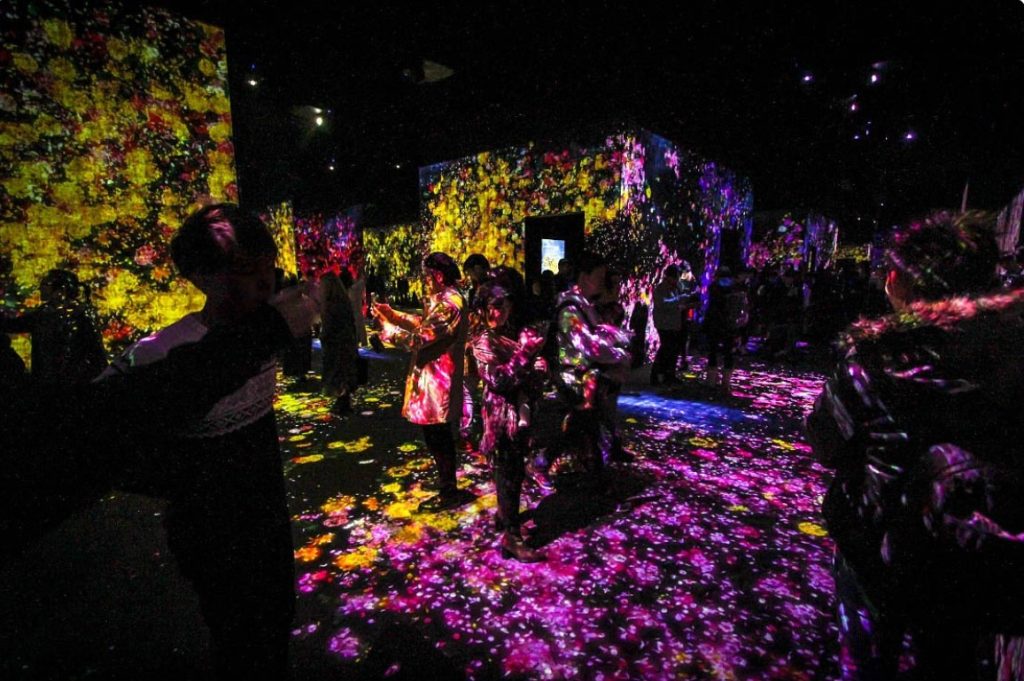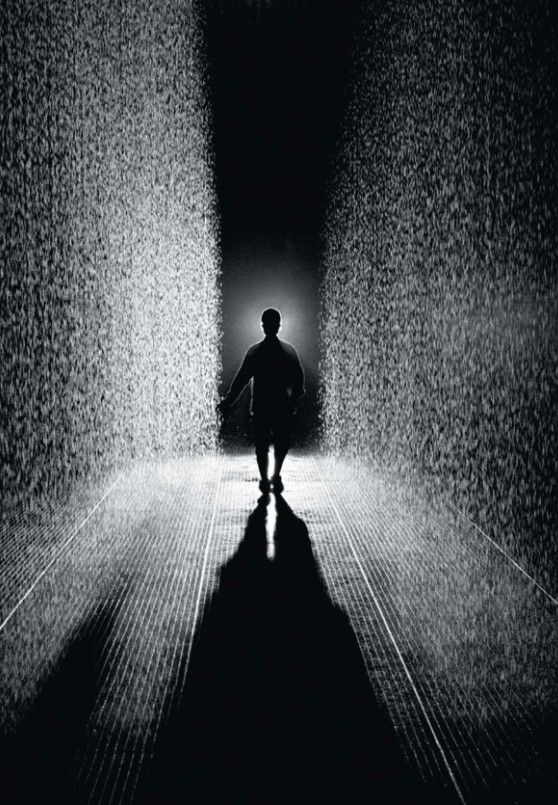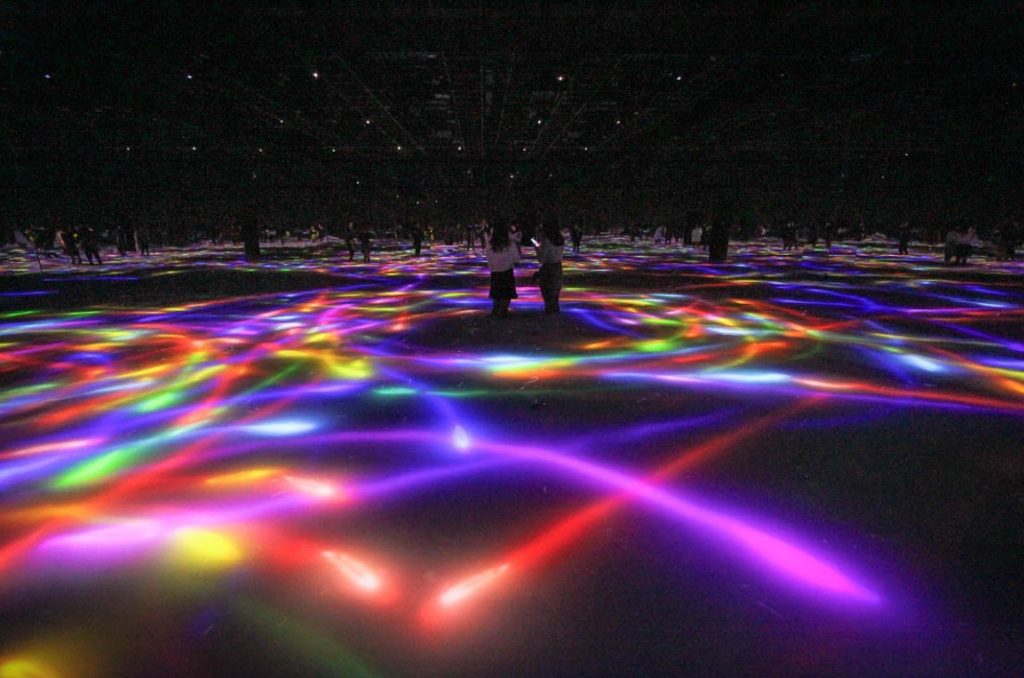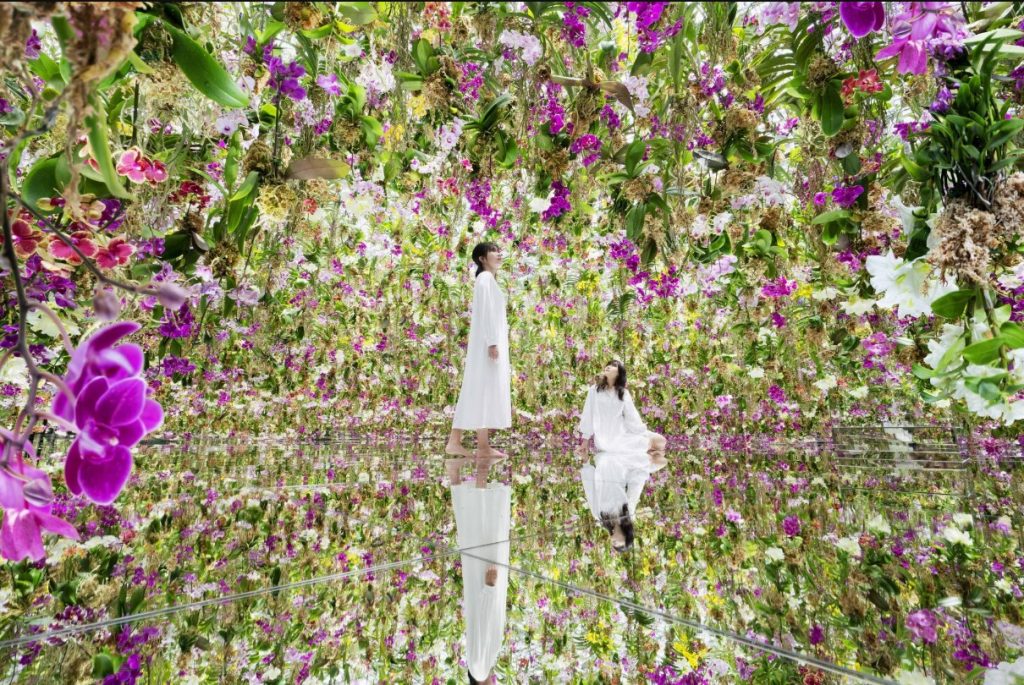Niveditha Ajay
A room made infinite by mirrors across every surface including the floor, with bunches of flowers hanging from the ceiling. As you walk closer to the bundles of luscious green leaves, yellow, pink, and purple flowers, sensors cause them to lift- forming a semicircle where the viewer stands. This is teamLab’s Hanging Flower Garden exhibit, housed currently at the National Museum of Emerging Science and Innovation in Japan. Integrating the diverse planes of art, nature, and human relationships with technological innovation, teamLab has hosted a variety of exhibitions featuring the concept, allowing for occurrence of free form and experimental art within fantastic spatial limits. Other pieces created by the collective include the use of LED displays, light sculptures and more recently displays based on the concept of the vortex.
teamLab is an art collective based in Japan initiated in 2001 by Toshiyuki Inoko. An international collective, the platform aims to “navigate the confluence of art, science, technology, and the natural world.” (Biography, teamLab). The group includes a variety of creatives who work across the vast arenas of digital art and media, fusing together motion and visuals. CG animators, architects, engineers, and traditional artists are all part of the crew putting together stellar installations. Transcending boundaries has always been a recurring theme in the work produced by the collective, with each exhibition attempting to traverse across the perceptions of the self and the other (nature, light, sound). Hence, everything is borderless. The wildly popular exhibits are housed in the Mori Building Digital Art Museum, apart from the teamLabs Planets gallery, Tokyo. Outside Japan, the collective has permanent exhibitions in the Museum of Contemporary Art, Los Angeles; Asia Society Museum, New York; Borusan Contemporary Art Collection, Istanbul and National Gallery of Victoria, Melbourne; among many others.

Source: Joe Mignano
Recently, the above-mentioned Hanging Flower Garden exhibit has been gaining great traction on social media platforms. The visually stimulating experience allows for an overwhelming sense of vastness to settle in, for the mirrors give an infinite dimension to the room. Once again, the distance between the human and the natural world is crossed as one sits in silence to observe the flowers. The immersive installation, like most of teamLab’s other projects, is very viewer centric, allowing for unique and almost ethereal experiences. The Hanging Flower Garden, though the most current curiosity, many other projects by the collective have become the subject of much discussion online and among modern art enthusiasts who visit Japan. The 2013, Rain Room exhibit is one of them, where artificial downpour created would stop the moment it detected a human body. This project too, relies on human interaction and participation to truly come alive as art. The Museum of Modern Art where the piece was installed, describes it as being, “a carefully choreographed downpour, simultaneously encouraging people to become performers on an unexpected stage and creating an intimate atmosphere of contemplation.” The centering of the individual as they come in contact with the human made science and technology, as well as the natural stimuli simultaneously, is an essential aspect.

Source: Joe Mignano
Odaiba’s Palette Town complex holds one of teamLab’s most widely visited and popularised exhibitions, Borderless. The first exhibit in the series, “Forest of Flowers and People: Lost, Immersed and Reborn,” opens from a dark entrance, featuring a room that appears to be in constant motion due to blooming flowers digitally displayed across all surfaces. The forests, flowers and butterflies are programmed to be rendered in real time and are not a pre-recorded loop. Fully interactive, the flowers may burst at touch or bloom around a completely still viewer. The pieces in the exhibition are also interconnected to appear borderless- the flowers flow into a waterfall that is caused by the draining of a pool exhibit on the floor above. Another significant installation is the “Wander through the Crystal World”- a room once again made expansive with mirrors with crystal shaped LED light strings suspended from the ceiling reflecting hues in different patterns. The maze-like arrangement can be controlled using the teamLab app downloaded on a phone- allowing the viewer to control the colour or the type of movement of the crystals. A similar arrangement of infinite mirroring and colour changing light is made use of in the “Forest of Resonating Lamps.” Hundreds of hanging lamps change their colour and brightness giving a floating effect, they react to the presence of viewers.

Source: Museum of Modern Art
teamLab Planets in Tokyo carries a lot of the permanent exhibits, becoming a tourist favourite over the past few years. The crystal vortex created in the “The Infinite Crystal Universe,” with its swelling music and extravagant display, has been described as overwhelmingly beautiful. The exhibit uses LED string lights that resemble crystals instead of the mirrors, retaining the high reflectivity and infinite nature. Comparing it to the Borderless exhibit, Mignano captures the emotion of the piece in saying- “the scale was much grander; less a world, and more a universe in itself,” further adding that they truly felt like they had “fallen into a vortex of space and time.” Another popular exhibit is the “Drawing on the Water Surface Created by the Dance of Koi and People – Infinity”, a pool of water through which the audience are encouraged to wade in with bare feet. Upon the water are projected hundreds of bright beams that resemble koi fish floating through the pond. Mignano noted that the fish were completely responsive to the viewers, the longer they stood the quicker they moved and the larger the numbers attracted.

Source: Joe Mignano
The whimsical and enchanting installations created by teamLabs have garnered popularity, interest and wide image circulation. However, the very same mass appeal has often earned the pieces apprehension from critics, some even questioning if the works can be considered art. The recent Hanging Flower Room too, has received allegations of being a simple money grab to trick easily appeased audiences. Yet, the role played by technology and visual media today is massive, images are pathways into individual minds- and what is art if not life? The centuries old, universal attempt at policing the limits of art works to only quell artistic expression, not allowing the very exploration that makes art happen. While the critics can still discuss and debate, it is undeniable that the curious interplay of audios, visuals and creativity in the pieces produced by teamLab have been incredible experiences for many.
SOURCES:
https://www.japan-guide.com/ad/teamlab/
https://www.teamlab.art/about/
https://www.moma.org/calendar/exhibitions/1352
https://www.teamlab.art/concept/Dissipative_Figures/





